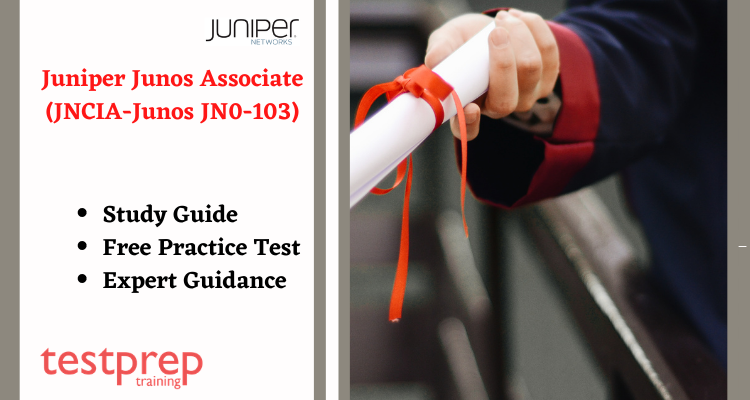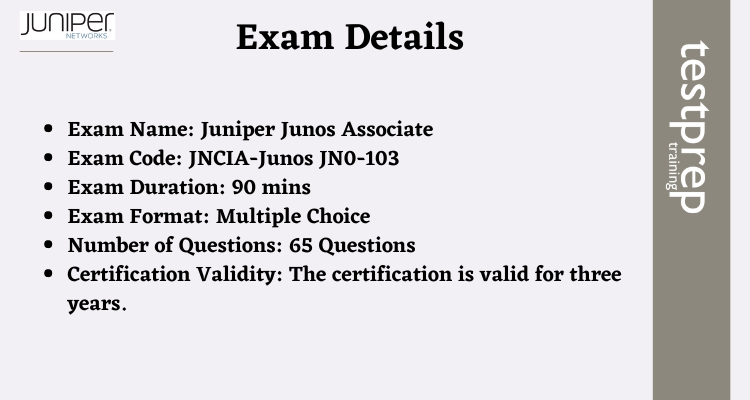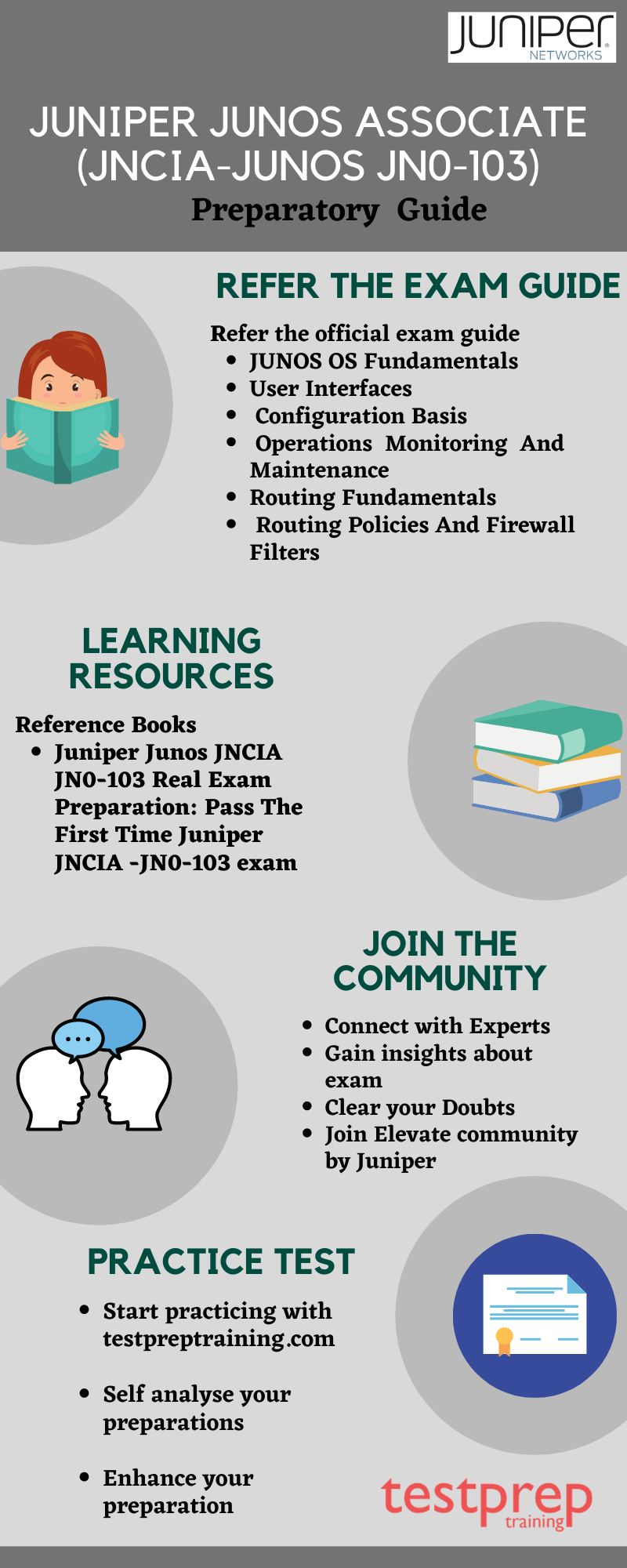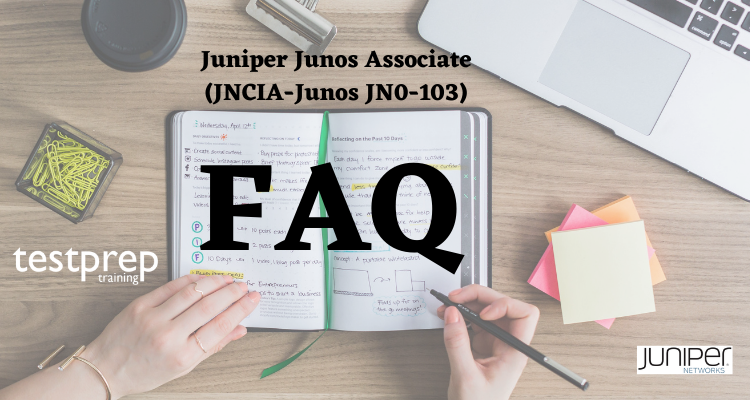Juniper Junos Associate (JNCIA-Junos JN0-103)

The Juniper Junos Associate (JNCIA-Junos JNO-103) examination is specially designed for candidates who have basic or intermediate knowledge of networking or are working as networking professionals. This written exam demonstrates the core understanding and functionality of the juniper networks Junos OS.
Exam Details
The exam code for this examination is (JNO – 103) and is conducted by Pearson VUE. The exam consists of 65 Multiple Choice Questions. The maximum time allocated for the examination is 90 minutes. The results will be declared immediately after the examination. It is a written examination and also, the pass/fail status is available immediately. The JNCIA-Junos JN0-103 Exam Cost is $165 USD. Moreover, this certification is valid for three years. Also the JNCIA-Junos JN0-103 Exam Questions are available in English language only.

Exam Registration
For registering, you may follow the following steps:
- Go to the official page of Juniper Networks
- Then scroll down to exam registration
- You will be redirected to the Pearson VUE page. Then scroll down to certManager ID and click on the Exam registration link
- If you already have an account with Juniper Networks sign in else sign up for a new account
- Follow the given instruction and complete the process.
- You will receive confirmation from the mail after the registration.
For more information, visit Juniper Junos Associate (JNCIA-Junos JN0-103) FAQ.
Exam Policies
There are various policies to which the candidate is required to adhere to. Juniper includes various exam policies to help candidates understand the terms and procedures for the certification exam. Some of them are:
Exam Retake Policy
The candidate has to wait for five calendar days, beginning the day after the failed attempt. However, once passed, a candidate must wait for a minimum of 180 days before taking the same exam with an identical exam number.
Exam Reschedule Policy
Candidates who want to reschedule their online proctored exam must contact Pearson VUE or access an online Pearson VUE account to reschedule the exam up until the scheduled start time of your appointment. However, failure to reschedule before your appointment time or failure to appear for your appointment will result in the forfeiture of your exam fee.
Cancellation Policy
To cancel the online proctored exam candidates must contact Pearson VUE or access your online Pearson VUE account to cancel your exam up until the scheduled start time of your appointment. However, failure to cancel before your appointment time or failure to appear for your appointment will result in the forfeiture of your exam fee.
Exam Recertification Policy
Certification status for exams expires after three years. However, reminders will be sent to the e-mail address reflected in CertManager. You can apply for recertification from your login portal.
Course Outline for Juniper Junos Associate (JNCIA-Junos JN0-103)
JUNOS OS Fundamentals
Identify the concepts, benefits, or functionality of the core elements of the Junos OS
- Software architecture (Juniper Documentation: Junos OS Architecture Overview)
- Control and forwarding planes (Juniper Documentation: Understanding the Chassis Cluster Control Plane)
- Routing Engine and Packet Forwarding Engine (Juniper Documentation: Routing Engine Architecture, Packet Forwarding Engine Architecture for T Series Routers)
- Transit traffic processing (Juniper Documentation: Traffic Processing on SRX Series Devices Overview)
- Exception traffic
User Interfaces
Identify the concepts, operation or functionality of the Junos user interface
- CLI functionality, modes, navigation and help (Juniper Documentation: CLI Overview, Overview of Navigating the CLI, help)
- Filtering output (Juniper Documentation: Filtering Operational Command Output)
- Active versus candidate configuration (Juniper Documentation: Comparing the Active or Candidate Configuration to a Prior Version)
- Reverting to previous configurations (Juniper Documentation: rollback)
- Modifying, managing, and saving configuration files (Juniper Documentation: Modifying Configuration Files, Managing Configurations)
- Viewing, comparing, and loading configuration files (Juniper Documentation: Loading Configuration Files)
- J-Web (core/common functionality only) (Juniper Documentation: J-Web Overview)
Configuration Basis
Identify the main elements for configuring Junos devices
- Factory-default state (Juniper Documentation: Factory Default Configuration)
- Initial configuration (Juniper Documentation: Initial Configuration Overview for Junos OS Devices)
- User accounts (Juniper Documentation: Junos OS User Accounts)
- Login classes (Juniper Documentation: Junos OS Login Classes Overview)
- User authentication methods (Juniper Documentation: Junos OS User Authentication Overview)
- Interface types and properties (Juniper Documentation: Physical Interfaces Properties Statements List)
- Configuration groups (Juniper Documentation: Using Configuration Groups to Quickly Configure Devices)
- Additional initial configuration elements, such as NTP, SNMP, and Syslog
- Configuration archival (Juniper Documentation: Backing Up Configurations to an Archive Site)
- Logging and tracing (Juniper Documentation: Tracing and Logging Junos OS Operations)
- Rescue configuration (Juniper Documentation: Rescue Configuration)
Operations Monitoring And Maintenance
Identify methods of monitoring or maintaining Junos devices
- Show commands
- Monitor commands
- Interface statistics and errors (Juniper Documentation: show interfaces statistics)
- Network tools, such as ping, traceroute, telnet, SSH, and so on (Juniper Documentation: Tools Menu)
- Junos OS installation and upgrades (Juniper Documentation: Software Installation and Upgrade Overview)
- Powering on and shutting down Junos devices (Juniper Documentation: request system power-off)
- Root password recovery (Juniper Documentation: Recovering Root Password)
Describe monitoring or maintenance procedures for a Junos device.
Routing Fundamentals
Identify basic routing concepts or functionality for Junos devices
- Traffic forwarding concepts (Juniper Documentation: Filter-Based Forwarding Overview)
- Routing tables (Juniper Documentation: Configuring Junos OS Routing Tables)
- Routing versus forwarding tables (Juniper Documentation: Junos OS Routing and Forwarding Tables)
- Route preference (Juniper Documentation: Route Preferences Overview)
- Routing instances (Juniper Documentation: Routing Instances Overview)
- Static routing (Juniper Documentation: Configuring Static Routing)
- Advantages of and use cases for dynamic routing protocols (Juniper Documentation: Understanding Dynamic Routing Policies)
Describe how to configure or monitor basic routing elements for a Junos device.
Routing Policies And Firewall Filters
Identify the concepts or functionality of routing policy and firewall filters on Junos devices
- Default routing policies (Juniper Documentation: Default Routing Policies)
- Import and export policies (Juniper Documentation: Understanding Routing Policies)
- Routing policy flow
- Effect of policies on routes and routing tables
- Policy structure and terms (Juniper Documentation: Actions in Routing Policy Terms)
- Policy match criteria, match types, and actions (Juniper Documentation: Routing Policy Match Conditions)
- Firewall filter concepts (Juniper Documentation: Firewall Filters Overview)
- Filter structure and terms
- Filter match criteria and actions (Juniper Documentation: Firewall Filter Match Conditions, Actions, and Action Modifiers)
- Effect of filters on packets
- Unicast reverse-path-forwarding (RPF) (Juniper Documentation: Configuring Unicast Reverse-Path-Forwarding Check)
- Describe how to configure or monitor routing policies and firewall filters on a Junos device. (Juniper Documentation: Configuring Firewall Filters (CLI Procedure))
Preparatory Guide For Juniper Junos Associate(JNCIA-Junos JNO-103)
Before appearing for the exam you need to be prepared for it thoroughly. With the right guidance, you can crack the exam with flying colors. But don’t you worry we got it all covered. This JNCIA-Junos JN0-103 Study Guide will help you throughout your journey. Let’s get started:

Refer the Exam Guide
Before you start preparing for your exam you need to know the basic structure and exam guide for your examination. For this specific exam, you need to go to the official website to get the exam guide and course outline. Mentioned below are some of the basic objectives of the Juniper Junos Associate (JNCIA-Junos JN0-103) examination:
- JUNOS OS Fundamentals
- User Interfaces
- Configuration Basis
- Operations Monitoring And Maintenance
- Routing Fundamentals
- Routing Policies And Firewall Filters
Learning Resources
After you are familiery with the course outline your next move to become a successful junos associate should be to start preparing in the right direction with the help of the right resources and study material. Mention below are all the help and resources you need to crack the JN0-103 Exam Questions:

Reference Books
Everything is now almost done. However, you are still confused to choose from which book to prepare, no worries we are here to help you. Out of many books and guides available out there in the market here are some of the handpicked best books out of them :
- Juniper Junos JNCIA JN0-103 Real Exam Preparation: Pass The First Time Juniper JNCIA -JN0-103 exam
Join A Community
By being a part of the Elevate community, it will help you understand more about the course the discussions in the group will help you to gain extra knowledge and develop skills which can help you to clear your exam. Therefore be a part of the official Juniper community Elevate community. Moreover, here you can start any discussion about the issue related to the exam or any query. By doing so, you will get the best possible answer to your query.
Evaluate yourself with Practice Tests
It is very important to practice what you have learned so that you are in a position to measure yourself on the scale. By practising you will be able to improve your answering skills that will result in saving a lot of time. Moreover, the best way to start doing practice tests is after completing one full topic as this will work as a revision part for you. So, start your preparation now with JNCIA-Junos JN0-103 Practice Tests!


